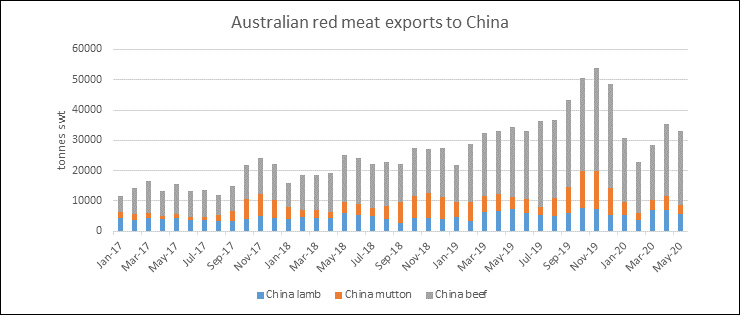June 23, 2020
African Swine Fever remains the key driver affecting global demand for beef and lamb, despite the effects of COVID-19.
Rabobank’s latest African Swine Fever Update shows Australia’s red meat exports to China remain strong despite recent hiccups in the trading relationship between the two countries.
The reports said African Swine Fever continues to restrict pork production in China, Vietnam, the Philippines and parts of eastern Europe.
Despite Australia’s total red meat exports being down 16 per cent year-on-year in May, exports to China were down only 4 per cent, reflecting strong Chinese demand in the wake of African Swine Fever.
Rabobank analyst Angus Gidley-Baird said considering Australia’s reduced production, current export figures highlighted China’s strong appetite for Australian meat.
“While exports into China are not quite at the levels they were at the end of last year – when African swine fever-driven pork shortages were driving strong Chinese demand and Australian production was much higher – they are close to levels seen at the start of 2019, which is a positive outcome for the domestic industry,” Mr Gidley-Baird said.
China’s pork production is expected to decline by a further 15 to 20 per cent in 2020, while in Vietnam and the Philippines, declines are expected to be close to 10 per cent, prompting further import demand from these countries.
In China, Mr Gidley-Baird said, pork imports were expected to reach record levels, while imports of other animal protein types would also be strong.
“China’s pork import growth accelerated in the first four months of 2020, with meat imports up 180 per cent, year-on-year, and variety meat imports up 29 per cent year-on-year,” he said.
Rabobank maintained its view that China’s pork imports would reach a record level of about 3.5 million metric tonnes in 2020, with the majority of product supplied from the US, under the US-China “Phase 1” trade deal.
However, Mr Gidley-Baird said imports for the rest of 2020 were still full of uncertainty, with disruptions to pork production and logistics in exporting countries, and movement in China’s domestic pork prices.
He said imports could ease through the current quarter, picking up again in quarter three and quarter four.
“But, COVID-19 and slower economic conditions aside, the protein gap created by African Swine Fever provides a strong demand force that will help support prices for Australian red meat exports for the remainder of 2020,” Mr Gidley-Baird said
“African Swine Fever will continue to underpin Chinese demand for Australian sheep and beef exports, as consumers look to substitute pork with alternative protein options.”
























